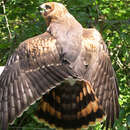More info for the terms:
backfire,
cover,
grassland,
headfire,
prescribed fireFires can open up grasslands and expose prey for northern harriers [
2].
However, northern harriers were not observed following prescribed fires
in a dry prairie grassland in Florida. The authors admit that counts
for large birds may have been underestimated. Fires were conducted in
January and again in late June. After the June fire, total bird
abundance for all species was lower on the burned site than on the
unburned control [
12].
Prescribed fire in North Dakota destroyed three of four northern harrier
nests, while one nest hatched following the fire [
18]. No nests were
initiated afterwards. Burning was conducted in mid-June using a
backfire on the downwind side followed by flank fires, and a headfire
across the upwind side.
To determine the effects on small mammal populations, fires were
prescribed on Malheur National Wildlife Refuge, Oregon, where northern
harriers are abundant [
6]. Fires in early November removed cover and
immediately reduced the small mammal population. However, small mammals
returned to burned sites the first and second postfire years. There was
an increase in small mammal numbers to above preburn levels during the
second postfire year, but this might have been due to above-average
winter temperatures.
Three years following prescribed burning in Wyoming, northern harriers
were not found on unburned plots or on plots burned in early June.
Northern harriers were found, however, on plots burned in late August.
Small mammal densities were high on the August-burned plots, and raptors
were observed preying upon the mammals. The prescribed burning involved
two fires, both conducted in a mountain big sagebrush (Artemisia
tridentata ssp. vaseyana) community. The first fire, set in early June,
resulted in patches of completely burned, partially burned, and unburned
areas. Plant cover on plots burned in June was 50 percent lower than on
control plots at the first postfire year. Cover was 79 percent of the
control by the third postfire year. The second fire was set in late
August, and all living and dead vegetation was consumed. Cover on
August-burned was 82 percent less than on control plots at the first
postfire year, and 54 percent of control plots by the second postfire
year.

